1-When catalog merchants dominated retail
In today’s always-on, constantly-connected world, it is almost inconceivable to imagine a time when retailing was not dominated by 24hr supermarkets, mass merchants, and warehouse club stores. This notion would have been foreign and unimaginable prior to the 1980s, when catalog merchants were stalwarts of retailing with such names as Service Merchandise, Modern Merchandising, Best Products, Montgomery Ward, and Consumers Distributing being major retail players.
Unlike self-serve retail stores, catalog merchants required customers to fill out order requests for items listed in the merchant’s catalog which would then be retrieved from the warehouse by store staff and brought out to the service counter for inspection and possible purchase.
Best sign, Texas (source: flicker.com)
A trailblazer in the “catalog showroom” concept, whereby goods were offered for sale both via catalog-order and self-serve retail, Best Products, also referred to simply as Best, would go on to become one of the most avant-grade American retailers.
Best t-shirt shopping bag (source: flicker.com)
2-Non-descript stores at Best
A natural by-product of the catalog business, where the sale can happen long before the customers steps foot in the store wass that the stores did not require being exceptional, memorable, or inspiring. In fact, the business model almost demanded that the store architecture be forgettable and unspectacular. Pre-selecting merchandise from a catalog in the comfort of their home, customers could opt to pick it up at a Best store, or alternatively, choose to have the merchandise sent directly to their home, avoiding the stores completely. The Best showrooms served an almost singular transactional purpose, and were designed to do that optimally.
Best Showroom, California (source: flicker.com)
A basic rectangular box, the typical Best showrrom espoused simplicity, low cost, and afforded speed of execution in the construction phase. The showroom was small, compact and located in densely populated areas with abundant parking. Best stores could afford to be architecturally unexceptional. The showrooms did not attempt to seduce, entice and entertain, they were designed for the convenience of commerce. That which Best lacked in cachet against the department stores was compensated for by comparatively lower prices.
Best showroom, Texas (source: flicker.com)
However, the catalog model would be seriously tested as the price advantage that catalog merchants enjoyed would soon fade as a new retail concept took hold and a legislative change came into effect. Price Club, founded in 1974 launched the warehouse retail business which would continue unabated. A year later, the US Congress repealed fair trade pricing.
Along with the rest of the industry, Best was clearly challenged to be spectacular, memorable, and exceptional.
3-Architectural experimentation in SITE
In the 1970s, art afficinados and Best founders, Sydney and Frances Lewis, contracted with architect James Wines and his firm, “Sculpture in the Environment” (SITE), to design several unorthodox, irreverent, imaginative and ironic retail showrooms. The basic, utilitarian, windowless box that was Best was having its façade manipulated, deconstructed, extruded, displaced and generally distorted. (source: siteenvirodesign.com/proj.best.php)
Best Peeling showroom, 1971 (source: siteenvirodesign.com)
Best Indeterminate Facade showroom, 1974 (source: siteenvirodesign.com)
Best Notch (closed) showroom, 1975 (source: siteenvirodesign.com)
Best Notch (open) showroom, 1975 (source: siteenvirodesign.com)
Best Tilt showroom, 1976 (source: seventeeneleven.com)
Best AntiSign showroom, 1978 (source: siteenvirodesign.com)
Best Cutler Ridge showroom, 1979 (source: siteenvirodesign.com)
Best Forest showroom, 1980 (source: siteenvirodesign.com)
Best Inside/Outside showroom, 1984 (source: siteenvirodesign.com)
The standard functional rectangular box with the equally bland and forgettable facades were enhanced by whimsical and expressive designs. Each of the SITE designed showrooms served both the business purpose while also offering social commentary, architectural interpretation, and unique destinations finally worthy of exceptionalism. United by their uniqueness under the comprehensive theme of challenging the status quo, the Best showrooms were being transformed into desirable destinations, as opposed to merchandise pick-up booths.
The Best showrooms by SITE were such a radical departure from their more pedestrian lineage that it was difficult not to notice. In December of 1979, the Museum of Modern Art (MoMA) opened an exhibit showcasing six façade designs by SITE for Best, along with models, photographs and commentary.
In 1979, Best would also collaborate with other architectural firms. Venturi and Rauch produced a colourful tapestry in the form of a flower-print porcelain steel panel clad façade to adorn an otherwise functional box store.
Best Langhorne Pennsylvania showroom (source: VenturiRauchScottBrownArchitect.com)
4-Industry consolidation and integration
Increasing competition and changes in the retail landscape would lead to dramatic consolidation within the catalog merchant industry. In the first half of the 1980s, Best would acquire competitors Basco and Modern Merchandising, integrate management structures, launch a new format prototype showroom, commit financially to upgrading many of the existing showrooms and add locations. By the later half of the 1980s, Best was closing unprofitable showrooms and shuttering other business ventures. (Discount Store News, May 13, 1985 and New York Times, September 27, 1988)
In 1990, after several years of catalog thining, Best announced an increase to the main catalog, distribution, and a renewed focus on three core areas, jewelry/giftware, housewares/home furnishing and home products (consumer electronics, photo and luggage). Four Houston (Texas) stores were revamped to mesh with this new focus. The new layout zoned the showrooms with housewares/home furnishings to the left, home products to the right, luggage in the rear and jewelry in a central island within a racetrack in the front of the store. (Discount Store News / Sept 17, 1990)
Best Products filed for Chapter 11 bankruptcy protection in 1991, and again in 1996. By May 1997, the bulk of the assets had been liquidated and Best was declared insolvent. (source: Wikipedia)
5-Best remembered as innovator
At the height of business, Best Products operated over 200 stores across the USA. Best had by far many more conventional and less dramatic showrooms, yet they are instantly remembered for a handful of odd, whimsical and exemplary stores which stretched, and subsequently tore apart the artistic envelope. Many of these unconventional showrooms have gained iconic status, becoming landmarks, tourist curiosities, and local attractions.
The SITE/Best collaboration produced some of the most recognizable images in retailing. Wikipedia suggests that photographs of James Wine’s Houston (Texas) building, the Inderteminate Façade showroom, have appeared in more books on 20th century architecture than photographs of any other modern structure. (Source:wikipedia)
Although Best crafted a memorable Architectural Identity leaning towards experiemental and unconventional designs, it was hampered by a business model which had become outmoded and superseded by the mass merchants, club stores, and internet retailers.
Many of the Best showrooms have since been torn down, converted, adapted or altered to be better suited to more conventional purposes, or to remove their artistic elements. As an architecture student, the Best Products showrooms by SITE were quasi de facto required reading for contemporary retail architecture. Due to Best Products’ willingness to experiment, challenge the accepted norms, and craft a truly unmatched Architectural Identity, the Best brand has cast a long shadow in retail design that remains undeniable, unforgettable, and truly innovative.
Disclaimer: All brands and trademarks are property of their respective owners.




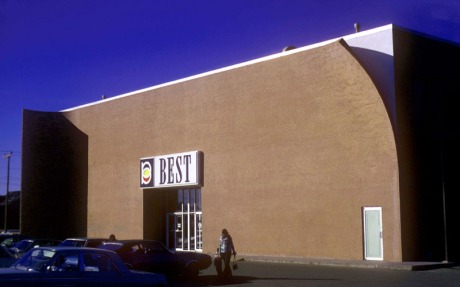

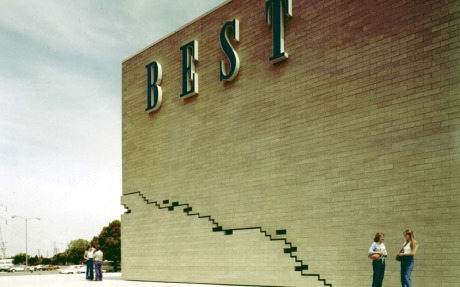
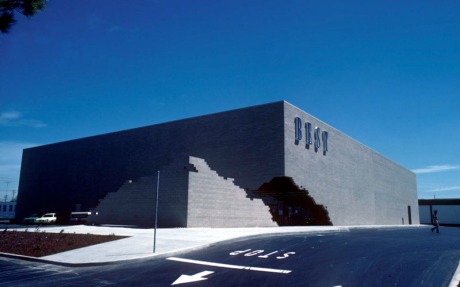
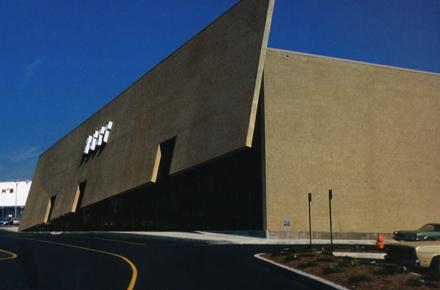
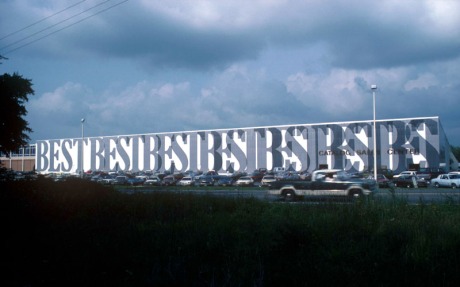


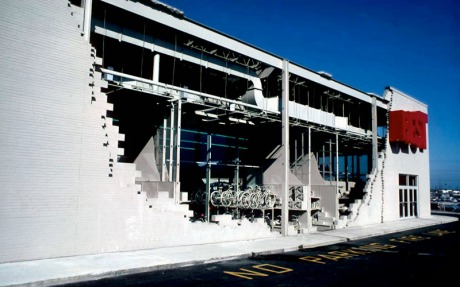
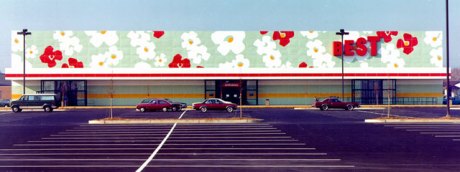
Companies like BEST enriched our society. When Whole Earth Access went under I new something was going wrong in America. I look back at that era and feel we have so lost our way as a nation. Profit has been taken from everything and soon there will be nothing left to profit from but poverty. Our once great nation that was a showpiece to the world in everything including Artistic Merchandising Showrooms has decayed into a new third world mentality marketplace
Posted by Dave Fox | October 6, 2013, 10:39 amas a child in the 80s, I loved going to the BEST store in NJ to buy toys. I wasn’t even paying attention to how it looked, only that the prices were very good, and they always had a complete collection for everything and anything I ever wanted. I still have the catalogs from that time, so nostalgic…
Posted by Glenn | July 23, 2014, 7:33 pmBest had a really generous return policy, maybe too generous. I liked seeing orders come down the conveyor belt when I was a kid.
Posted by Tracy M | November 8, 2014, 11:54 pmLoved the video you recommended. Had no idea about these wonderful stores. Ours was nothing special.
Posted by Tracy M | November 9, 2014, 12:05 amthey forgot the one on rooselvelt blvd that was a basco
Posted by Glenn Woodley | April 4, 2015, 9:05 pm